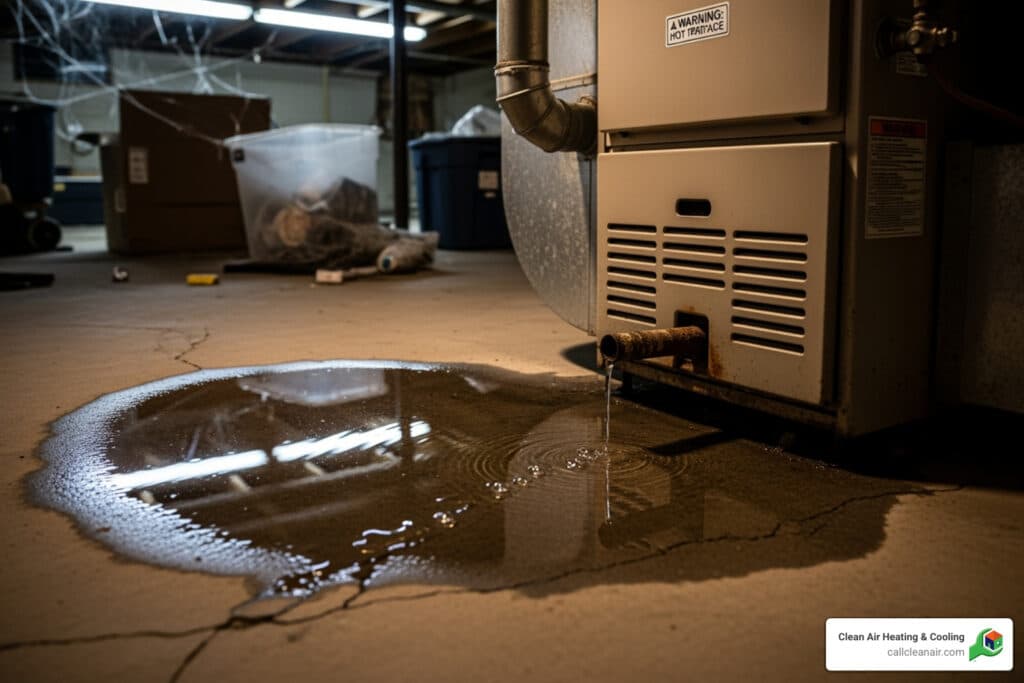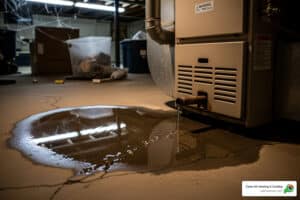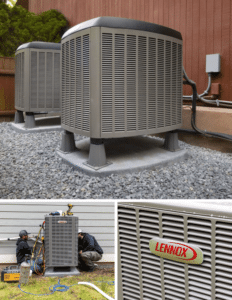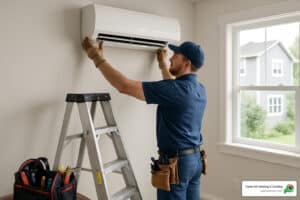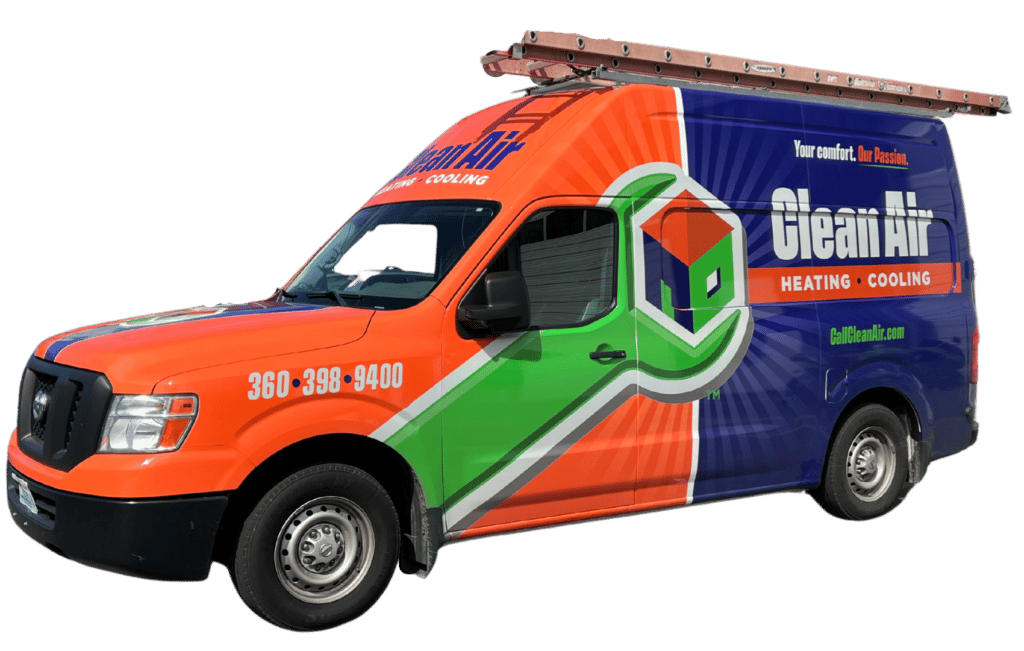Why Is Your Furnace Leaking Water?
Finding a puddle near your furnace is a common concern for homeowners asking, “why is furnace leaking?”. While alarming, understanding the cause is the first step toward a solution.
Common reasons for a furnace leak:
- High-efficiency furnaces: Normal condensation from the secondary heat exchanger gets backed up.
- Clogged condensate drain line: Algae or debris blocks water drainage.
- Faulty condensate pump: The pump fails to remove water (lifespan is 3-5 years).
- Leaky humidifier: Water lines crack or components get clogged.
- Clogged air filter: A frozen coil melts and overflows.
- Damaged flue pipe: An improper slope causes condensation backup.
- Air conditioner leak: Water drips from the AC unit above the furnace.
The type of furnace you have is a key factor. High-efficiency furnaces naturally produce water during heating, while standard furnaces should never leak under normal operation.
Water damage from a leaking furnace can cost between $1,300 and $6,200 to repair, making quick action essential.
I’m Colin Matei, Owner of Clean Air Heating & Cooling. With years of HVAC experience serving Whatcom, Skagit, and Snohomish Counties, I know that proper diagnosis and timely repairs prevent minor leaks from becoming major disasters.
Related HVAC Topics:
First Steps: What to Do When You Find a Furnace Leak
Finding water pooling around your furnace is stressful. While it’s natural to ask, “why is furnace leaking,” the priority is taking quick, smart action to protect your home and family.
Safety comes first, so cut the power to your furnace immediately. You can either flip the dedicated circuit breaker in your electrical panel or use the furnace switch (it looks like a light switch) on or near the unit. This step eliminates the danger of water meeting electricity.
With the power off, tackle the water. Use towels for small puddles or a wet/dry vacuum for larger messes. Clean up every drop you can find to prevent expensive damage and mold growth in floors and walls.
As you clean, try to note where the water is coming from. Is it a steady drip or a gush? Is the water clear or discolored? These details help our technicians solve your “why is furnace leaking” mystery faster.
A common mistake is attempting a solo fix. Even if the cause seems obvious, the smart move is calling a professional. Furnace systems are complex, and a simple-looking problem can signal a bigger issue.
Our Furnace Troubleshooting Tips can help you understand what you’re seeing, but we’re here to take the guesswork out of the equation. With the right tools and experience serving Bellingham and the surrounding areas, we can identify the real source of the leak and fix it correctly the first time.
Don’t let a small puddle become a big headache. Call a professional to get back to a warm, dry home.
High-Efficiency vs. Standard Furnace: Why Your Furnace Type Matters
When investigating why is furnace leaking, the first step is identifying your furnace type. This single clue helps narrow down the possible causes. You don’t need to be an HVAC expert—just look at the vent pipes coming from your unit.
High-Efficiency (Condensing) Furnaces
If you see white plastic (PVC) pipes, you have a high efficiency furnace. These units send hot exhaust through a secondary heat exchanger, cooling it until water vapor condenses into liquid.
This process allows them to achieve an annual fuel utilization efficiency (AFUE) of 90% or higher by extracting extra heat that older models waste.
This means water production is completely normal for high-efficiency furnaces. The water, or condensate, is collected and drained away through the PVC pipes. If you’re wondering why is furnace leaking and you have this type of unit, the problem is almost always in the drainage system.
Standard-Efficiency (Conventional) Furnaces
If you spot a metal vent pipe, you have a standard-efficiency furnace. These units send hot exhaust gases directly outside without the secondary heat extraction step.
The key difference is that standard furnaces should never produce water during normal heating. Their AFUE ratings are typically below 90%, and their exhaust isn’t cooled enough to create condensation.
If you find water near a conventional furnace, the cause is external, such as a leaky whole-house humidifier or the air conditioner that often sits above it. This distinction is critical for a fast and accurate diagnosis.
[TABLE] comparing High-Efficiency and Standard-Efficiency Furnaces
| Furnace Type | How it Works | Vent Pipe Material | Normal Water Production |
|---|---|---|---|
| High-Efficiency (Condensing) | Uses a secondary heat exchanger to cool exhaust gases, causing water vapor to condense. This extracts maximum heat from the fuel. | White PVC | Yes (condensate) |
| Standard-Efficiency (Conventional) | Heats air through a single heat exchanger and vents combustion gases directly outside without additional cooling. | Metal | No |
When you call us, knowing whether you have PVC or metal pipes gives us a huge head start on solving your problem and getting your system back to normal quickly.
Why is my furnace leaking? 7 Common Culprits
Now that we’ve covered furnace types, let’s dive into the common reasons why is furnace leaking. Over years of service in Bellingham and Whatcom County, we’ve seen these same issues repeatedly.
1. Clogged Condensate Drain Line
This is the most frequent culprit for high-efficiency furnaces. The condensate drain line can become clogged with algae growth, dirt, and debris. When the line backs up, water overflows the drain pan and puddles around the furnace base. While some homeowners clear minor clogs with a wet/dry vacuum, it’s best to be cautious to avoid damaging the line.
2. Malfunctioning Condensate Pump
Many high-efficiency furnaces use a condensate pump to remove water, especially in basements. These pumps have a 3-5 year lifespan. When one fails, gets clogged, or its float switch breaks, it can no longer pump water out. You’ll often see water dripping directly from the pump itself. These units typically require professional replacement.
3. Leaky Humidifier
A whole-house humidifier is a common source of leaks, especially for standard-efficiency furnaces. A leak can be caused by water line cracks, a clogged filter, or internal supply issues. Since the humidifier is attached to the furnace, its leak can be easily mistaken for a furnace problem.
4. Clogged Air Filter
Surprisingly, a clogged air filter can cause a water leak. A dirty filter restricts airflow over the AC’s evaporator coil (usually located above the furnace), causing it to freeze solid. When the system cycles off, the melting ice overflows the condensate drain pan, mimicking a furnace leak. This is why regular HVAC Filter Replacement is so important.
5. Improperly Sloped or Damaged Flue Pipe
This issue primarily affects standard-efficiency furnaces with metal exhaust pipes. If the exhaust pipe has an incorrect slope or is damaged, condensation from combustion gases (or even rainwater) can collect inside. This water then runs back down the pipe and drips into or around your furnace, which can cause rust and corrosion.
6. Cracked Secondary Heat Exchanger
This is a serious issue found in high-efficiency furnaces. The secondary heat exchanger can develop cracks from stress over time. A cracked secondary heat exchanger not only leaks water but also poses a dangerous carbon monoxide risk. This is an emergency that requires immediate professional attention and is one of the most critical Signs My HVAC System Needs Repair.
7. It’s Actually Your Air Conditioner
Sometimes the leak isn’t from the furnace at all, which is common with summer leaks. In many shared HVAC systems, the AC evaporator coil sits above the furnace. If the AC drain line gets clogged or the drain pan overflows, water drips down onto the furnace below. It’s a classic case of mistaken identity.
The Dangers of a Leaking Furnace: More Than Just a Puddle
A puddle around your furnace is more than just a mess. The reason why is furnace leaking matters because a small leak can signal major problems. Ignoring it can lead to serious consequences for your home, health, and safety.
Water Damage and Mold Growth
Even a small, steady drip can cause significant damage. Water seeps into flooring, causing it to warp, buckle, or swell. It can also reach subflooring and drywall, leading to structural rot and unsightly stains. The reality is that water damage from a leaking furnace can cost between $1,300 and $6,200 to repair.
Worse, moisture creates the perfect environment for mold and mildew. Mold spores spread through the air, causing musty odors and triggering respiratory issues and allergic reactions. A leaking furnace can definitely cause mould growth, which is expensive and difficult to remove completely.
Electrical Hazards and System Failure
Water and electricity are a dangerous mix. When water enters your furnace’s electrical components, it can cause short circuits, damage the control board, and create a fire hazard. Moisture also leads to rust and corrosion on metal parts, including a potential blower motor failure, which shortens your furnace’s lifespan and leads to costly repairs or a complete system shutdown.
Why is my furnace leaking and is it a carbon monoxide risk?
This is the most critical danger. While most leaks are water-related, a cracked heat exchanger in a high-efficiency furnace is a life-threatening exception. A crack not only leaks water but can also allow deadly carbon monoxide (CO) gas to escape into your home.
CO is invisible, odorless, and tasteless, making it impossible to detect without a proper alarm. Its poisoning symptoms mimic the flu (headaches, dizziness, nausea), which can lead to tragic delays in seeking help.
This is why working CO detectors on every level of your home are essential. If your furnace is leaking and you suspect a cracked heat exchanger, or if your CO alarm sounds, evacuate your home immediately and call 911. Once safe, call us for urgent professional help. Our technicians have the specialized equipment for Bellingham Furnace Repair to safely handle these emergencies.
Prevention is Key: Keeping Your Furnace Leak-Free
The old saying, “an ounce of prevention is worth a pound of cure,” is especially true for furnace leaks. Proactive care is the best way to avoid water damage and costly repairs, just like regular oil changes for your car.
The Importance of Regular HVAC Maintenance
Annual tune-ups are the best investment for your furnace’s health. Our certified technicians thoroughly inspect all components that could cause leaks, including drain lines, condensate pumps, and the heat exchanger. This early problem detection allows us to fix a developing issue long before it becomes a puddle on your floor.
We also clean condensate lines and ensure all connections are secure. Beyond preventing leaks, regular maintenance extends your furnace’s lifespan and improves efficiency. Our HVAC Maintenance Plans make this easy and affordable. You can also review our Furnace Maintenance Checklist to see what a professional tune-up includes.
Why is my furnace leaking? Check your filter!
As mentioned before, regularly changing your air filter is one of the simplest and most effective ways to prevent leaks. A clogged filter restricts airflow, which can cause the evaporator coil to freeze and then overflow when it melts.
We recommend checking your filter monthly and replacing it every 1-3 months, depending on your home. If you have pets or family members with allergies, you may need to change it more often. This simple task can save you from a major headache.
[LIST] of Signs Your Furnace Needs a Check-Up
Your furnace often gives warning signs before a major problem occurs. Call for a professional check-up if you notice:
- Unusual noises like banging, rattling, or squealing
- Frequent cycling (turning on and off more than usual)
- Higher energy bills without a change in usage
- Uneven heating in different rooms
Don’t ignore these signals. They are your furnace’s way of asking for help before a small issue becomes a major breakdown.
Don’t Ignore the Drip: Trust the Experts
We’ve covered why your furnace might be leaking, from common culprits to the differences between furnace types. We’ve also seen that an ignored drip can lead to serious dangers beyond just a puddle.
The bottom line: whether it’s a simple clogged drain or a serious cracked heat exchanger, answering “why is furnace leaking” is a job for a professional. A leak is a potential threat to your property, wallet, and family’s safety.
Putting off a call for help can lead to thousands in water damage, electrical issues, or even a dangerous carbon monoxide risk. That small drip today could become a major disaster tomorrow.
At Clean Air Heating & Cooling, we understand the stress of a furnace leak. We’ve built our reputation on providing prompt, reliable service throughout Bellingham, Whatcom, Skagit, Snohomish, San Juan, and Island Counties. Our NATE-certified technicians bring years of experience to quickly and accurately diagnose the problem.
We provide thorough inspections, clear explanations, and customized solutions. Our commitment is reflected in our over 480 5-star Google reviews from neighbors who trust us with their home comfort and safety.
Don’t let a drip turn into a disaster. Your furnace is sending a signal, and we’re here to help. For expert HVAC Services and professional answers to why is furnace leaking, reach out to Clean Air Heating & Cooling today. We’ll keep your home warm, safe, and dry.

